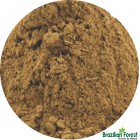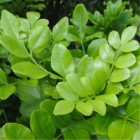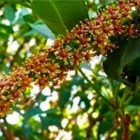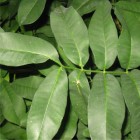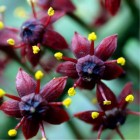Jaborandi Leaves Powder
- Brand: Brazilian Forest
- Product Code: Plantas Medicinais
- Availability: In Stock
The Pilocarpus species are distributed in a large region of the American continent. There are 16 species described for this genus, from these 13 can be found in Brazil, and 11 occur exclusively in the Brazilian territory. Started to be studied concerning their pharmacological properties in 1873, when it was confirmed that “jaborandi” was a potent stimulant of the secretory system, showing sialagogue, diuretic and diaphoretic activities. Since then, infusions of “jaborandi” leaves have been used for the treatment of fevers, stomatitis, bronchitis, gout, psoriasis, kidney diseases and several others illnesses. After the isolation of the imidazole alkaloid pilocarpine, in 1875 and its employment in ophthalmology, the “jaborandi” reached the status of one of the most important plants in the Brazilian flora. Besides alkaloids, a number of secondary metabolites have been reported in Pilocarpus species such as coumarins, flavonoids, hydrocarbons, triterpenes and volatile oils
CONSTITUENTS: This plant is a rich source of imidazole alkaloids such as pilocarpine, isopilocarpine, pilosinine, isopilosine, epiisopilosine and epiisopiloturin. Pilocarpine is the best known of the jaborandi alkaloids and the only one with commercial value, used both as a miotic and diaphoretic agent due to its action as a peripheral stimulant of the parasympathetic system. From this set of structurally related molecules, only pilocarpine has a defined biological activity. However, imidazole alkaloids display a wide range of pharmacological activities. They have been used as antiparasitic, antibacterial, antimicobacterial, antitumoral, antioxidant and antifungal agents. This indicates that the alkaloid extract of jaborandi leaves harbor a still unexplored set of molecules with potential application in human health, such as putative antimicrobial compounds that can be further developed in alternative treatments for infectious diseases.
LATIN NAME: Pilocarcus jaborandi spp.; Pilocarpus microphyllus / Pilocarpus pennatifolius
USED PARTS: Leaves
DRYING METHOD: Sun dried
ACTIVE INGREDIENTS: alkaloids (pilocarpine, isopilocarpine, pilosinine, isopilosine, epiisopilosine and epiisopiloturin), coumarins, flavonoids, hydrocarbons, triterpenes and volatile oils.
PROPERTIES: Known for its intensive use in the pharmaceutical industry, jaborandi is in the control of glaucoma, due to the capacity of the pilocarpine, alkaloid found in its leaves, to produce increase in the contraction of the smooth muscle and relaxation of sphincters of any animal organism. The medicinal properties of this plant, both by internal and external use, are which results in pilocarpine, the main active constituent, as well as pilosin, which in the form of sulfate, tartrate and hydrochloride, is effective in the treatment of acne, hair loss, seborrhea and other conditions of the scalp with local preparations. The salts of pilocarpine enter into the composition of eye drops, ointments and hypodemic injections used in ocular pressure control in cases of glaucoma and, all of them restricted to the medical prescription. Its extracts and pilocarpine itself are also used as an antidote to the poisoning of Solanaceae alkaloids and their products. Pilocarpine is a parasympathomimetic agent, stimulates the sweat, salivary, lacrimal, gastric, pancreatic, and intestinal glands and mucous membranes of the respiratory tract. It has been used to decrease intraocular pressure. Pilocarpine can be used to decrease the secretion of the mouth and throat in the disorders caused by cancer radiotherapy in these places. In veterinary medicine it is used as a stimulant of secretions and movements of the gastrointestinal tract especially the rumen. Another alkaloid, epiisopiloturine found in jaborandi, has been demonstrated effectiveness against schistosomiasis.
PREPARATION: Pilocarpine (active substance) is destroyed with boiling, then maceration or infusion should be used. As jaborine in the body has an antagonistic effect to that of pilocarpine, internal use of it is safer in commercial form (purified), under medical supervision. The internal use of macerated or infusion should only be practiced with medical follow-up.
- decoction for external use of 50g / liter of water: rinse the hair;
- infusion for internal use of 20g of the leaves in a liter of water. Take 2 cups a day between meals;
- powder of the leaves, for internal use: 2 to 5g per day, divided into maximum doses of 0.5g each;
- tincture: 2 to 5ml per day.
APPLICATIONS: Nutraceuticals, dietary supplements, medicinal herb, medicinal plant, phytoterapic, pharmaceutical, cosmetics.
PRECAUTIONS: Jaborandi should not be taken during pregnancy or while breastfeeding. Both jaborandi and pilocarpine may cause headaches and can irritate the stomach and cause vomiting and nausea. An overdose may cause such symptoms as flushing, profuse sweating and salivation, urinary frequency, nausea, rapid pulse, contracted pupils, diarrhea or fatal pulmonary edema. The plant may induce bradycardia. Those with cardiac or circulatory conditions should not take jaborandi.
Consult your pharmacist or physician or other healthcare professional before using.
For educational purposes only. This information is not intended to diagnose, treat, cure or prevent any disease.



